USPTO's Speed On Some China Patents Bears A Closer Look
Originally published on Law360
Julie Burke, Ph.D.

The U.S. Patent and Trademark Office's Patent Prosecution Highway, or PPH, grants expedited examination to applications containing claims found patentable by an Office of Earlier Examination, or OEE.[1]
With its motto of "faster IP rights, reduced costs," more than 75,000 PPH applications have been examined by the USPTO since 2006. The PPH program, summarized in a USPTO-provided diagram shown below, offers a higher allowance rate than nonprogram applications, presumably because the claims have already been searched, examined and granted in another patent jurisdiction.[2]
The PPH is a fee-free expedited examination program in which U.S. patentability decisions are made after considering findings made by another patent office.
The USPTO has raised concerns that the increased quantity of patent applications by Chinese entities could stretch the capacity of patent examiners and narrow the scope of protection available for legitimate rights holders.[3]
This article considers whether China-originating PPH applications, which contain claims that sufficiently correspond to those examined and allowed by the China National Intellectual Property Administration, or CNIPA, are examined by USPTO examiners differently than U.S. PPHs.
Favorable Examination and Allowance of China-Originating Expedited Applications
Using Petition.ai, 203 applications were identified that contained (1) a PPH petition granted between November 2022 to April 2023 and (2) at least one USPTO action on the merits. The phrase "U.S.- originating PPH" refers to petitions filed by U.S. inventors or applicants. Other PPHs were grouped as follows:
- 48, from European countries where English was not the official language; Julie Burke
- 41, from Japan, Korea and Taiwan;
- 38, filed by entities from the People's Republic of China; and
- 22, from Canada, Great Britain, Australia and New Zealand.
Patent center file histories were analyzed to determine how many PPHs, sorted by country or region, received favorable first action or issued as a patent.
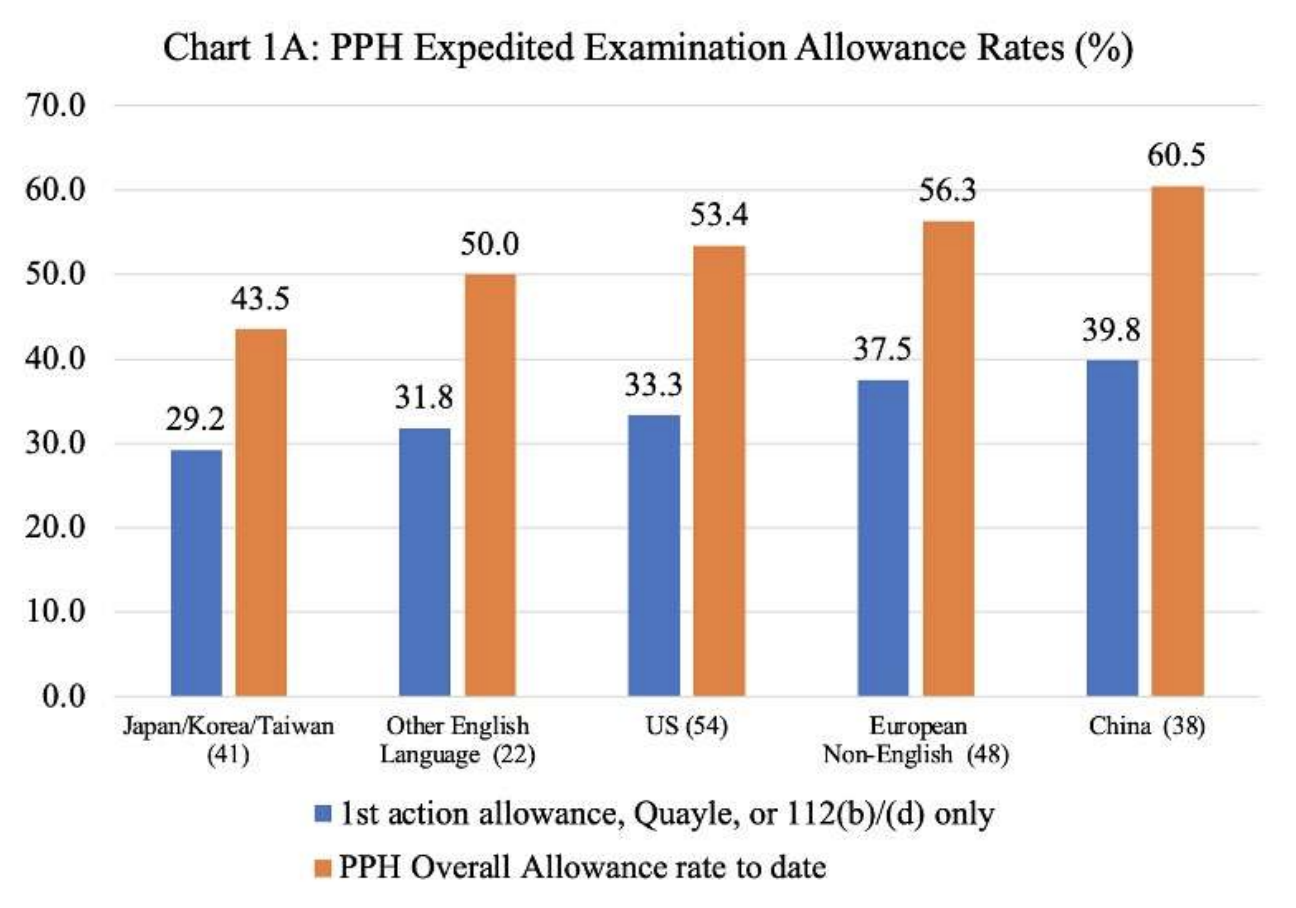
Chart 1A shows patent issue and favorable first action rates varied from lower, Japan, to higher, China. Here, a favorable first action is defined as (1) a notice of allowance, (2) an ex-parte Quayle action allowing all claims except for minor objections or technical requirements, and (3) actions that only rejected claims for indefiniteness or improper claim dependency under 35 U.S.C. 112(b) or (d).
Chart 1B shows that favorable actions and allowances were prepared faster for China PPHs as compared with U.S. PPHs.
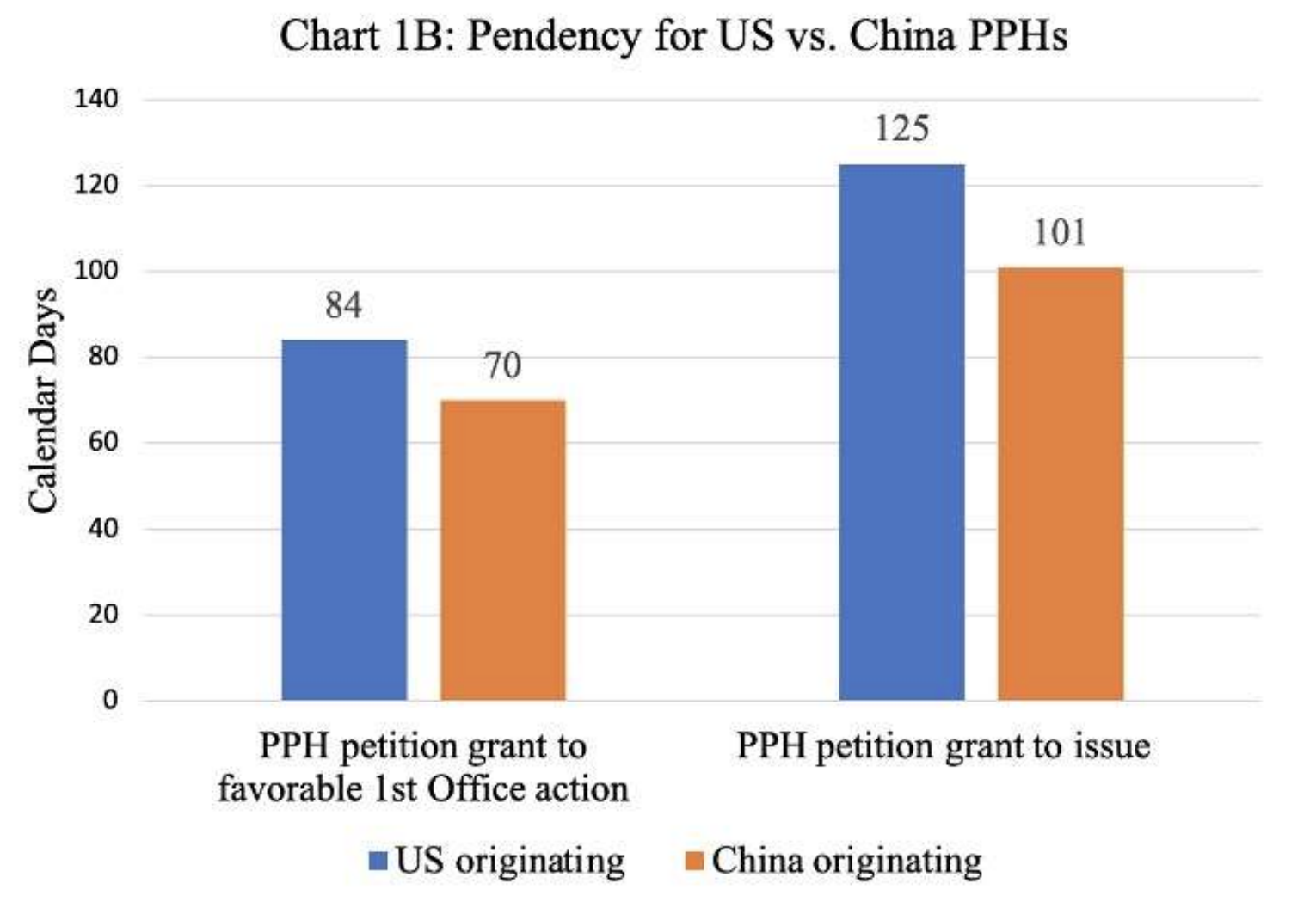
Expedited Examination Process
Applications processed under any expedited program, including a PPH, are to be substantively examined according to U.S. law and guidelines in the same manner as nonPPHs, with no guarantee that the result of the U.S. examination will match that of the OEE.
Yet analysis of the surveyed PPH actions indicated marked procedural differences in the examination process depending upon whether the PPH was filed by a U.S. entity or a China entity. As a proxy for the extent of search and examination, the number of references cited by examiners on PTO892 forms and action page lengths were tallied and averaged as shown in Chart 2.

U.S. examiners wrote longer, or an average of 16.1-page, actions for U.S.-originating PPHs and shorter, or an average of 9.9-page, actions for China-originating PPHs.
U.S. examiners cited more relevant documents, or 6.2 pages, for U.S. PPHs and fewer, or 3.8 pages, for China PPHs.
These results suggest two possibilities: Either (1) claims in China PPHs are in better condition for allowance, while the claims in U.S. PPHs have more substantive problems requiring rejections, responses, argument, evidence or amendment, or (2) U.S. examiners are not examining China PPHs as thoroughly as other PPHs.
Patent Application Quality
Examination differences could be attributed to the quality of the patent application. Small or micro entities may not have as much access to resources needed to perform a thorough search and prepare a high-quality patent application as large entities.
It's reasonable to expect that poorly drafted patent applications would be subject to more types of rejections. Yet Chart 3 shows U.S.- and China-surveyed PPHs have similar entity status distribution suggesting other factors account for examination differences.
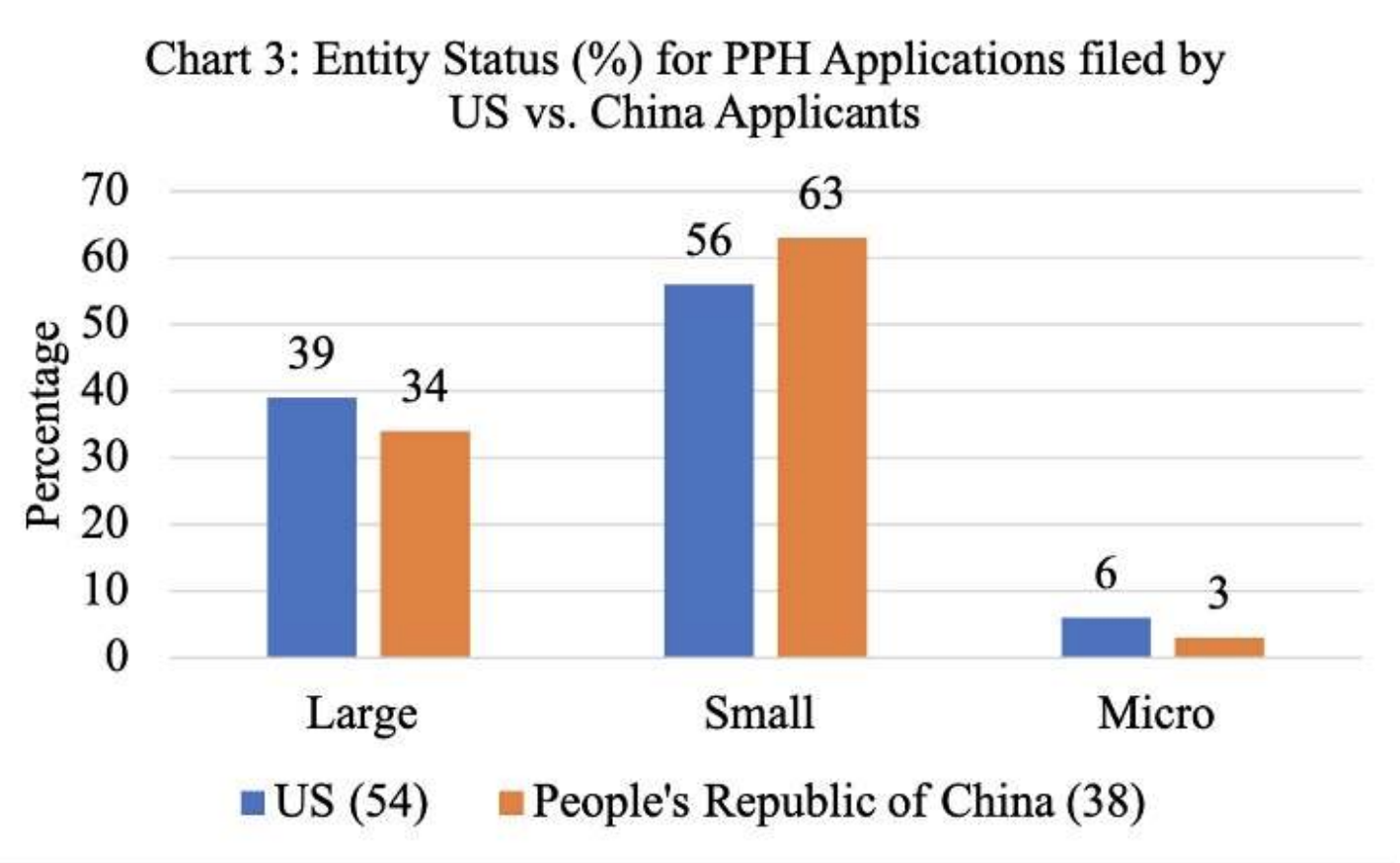
The survey was expanded to include applications expedited under the recently extended Climate Change Mitigation Pilot Program, or CCM.[4][5] Using Petition.ai, 44 applications were identified with CCM petitions granted from June 2022 to April 2023, and at least one action.
CCM decisions are in the application's official record. However, no CCM petitions were found in the USPTO's official record. Petition.ai has previously identified the vast majority, or 84%, of retroactive foreign filing license petition decisions[6] as missing from the official record.
CCMs have similar entity status distributions as surveyed PPHs. Action page length and number of references cited by examiners for 27 U.S. CCMs and 14 China CCMs exhibited the same disparity as observed for PPHs.
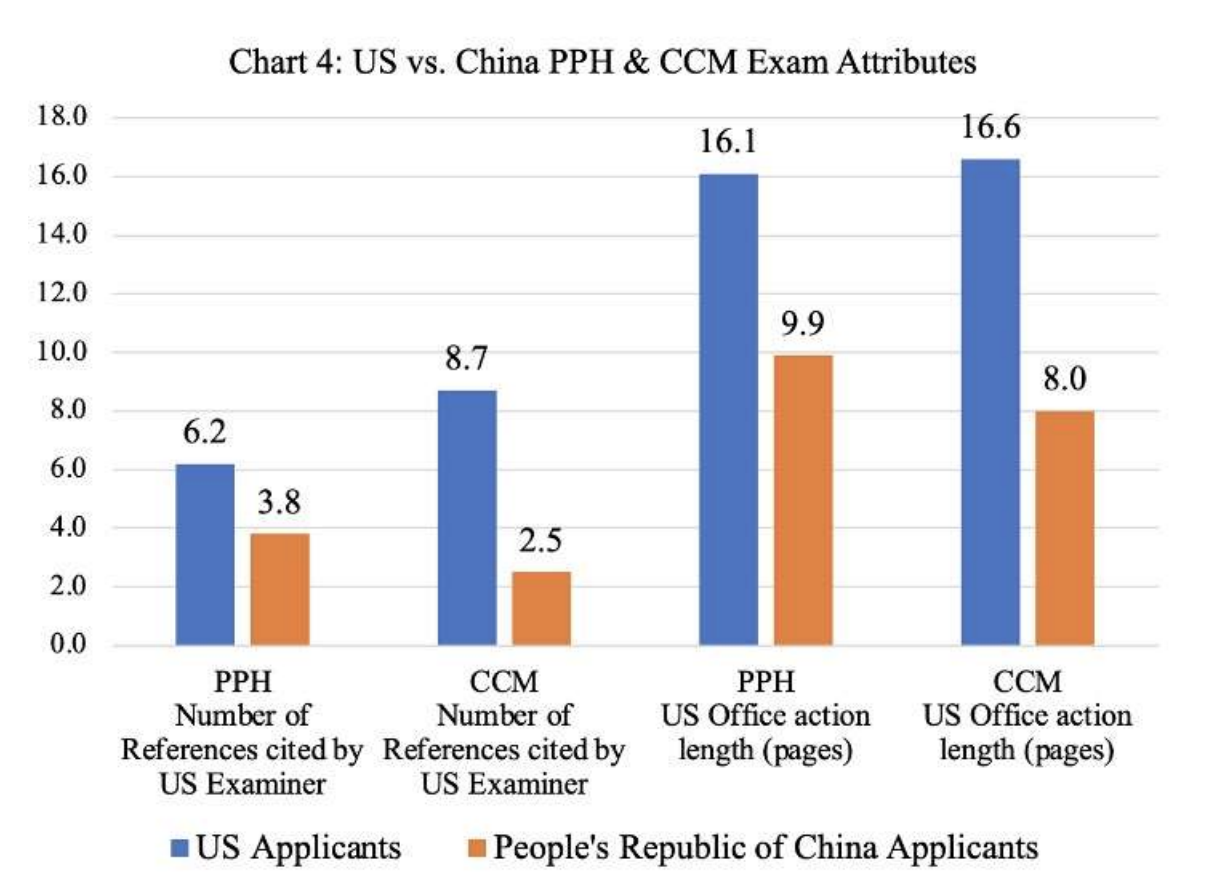
On average, U.S. examiners wrote significantly longer actions and cited more references for U.S.-filed PPHs and CCMs than for China-filed PPHs and CCMs.
Substantive Examination Disparities
Chart 5 shows the number of anticipation rejections under Title 35 of the U.S. Code, Section 102 and obviousness rejections under Title 35 of the U.S. Code, Section 103 made for U.S.- and China-originating expedited applications.
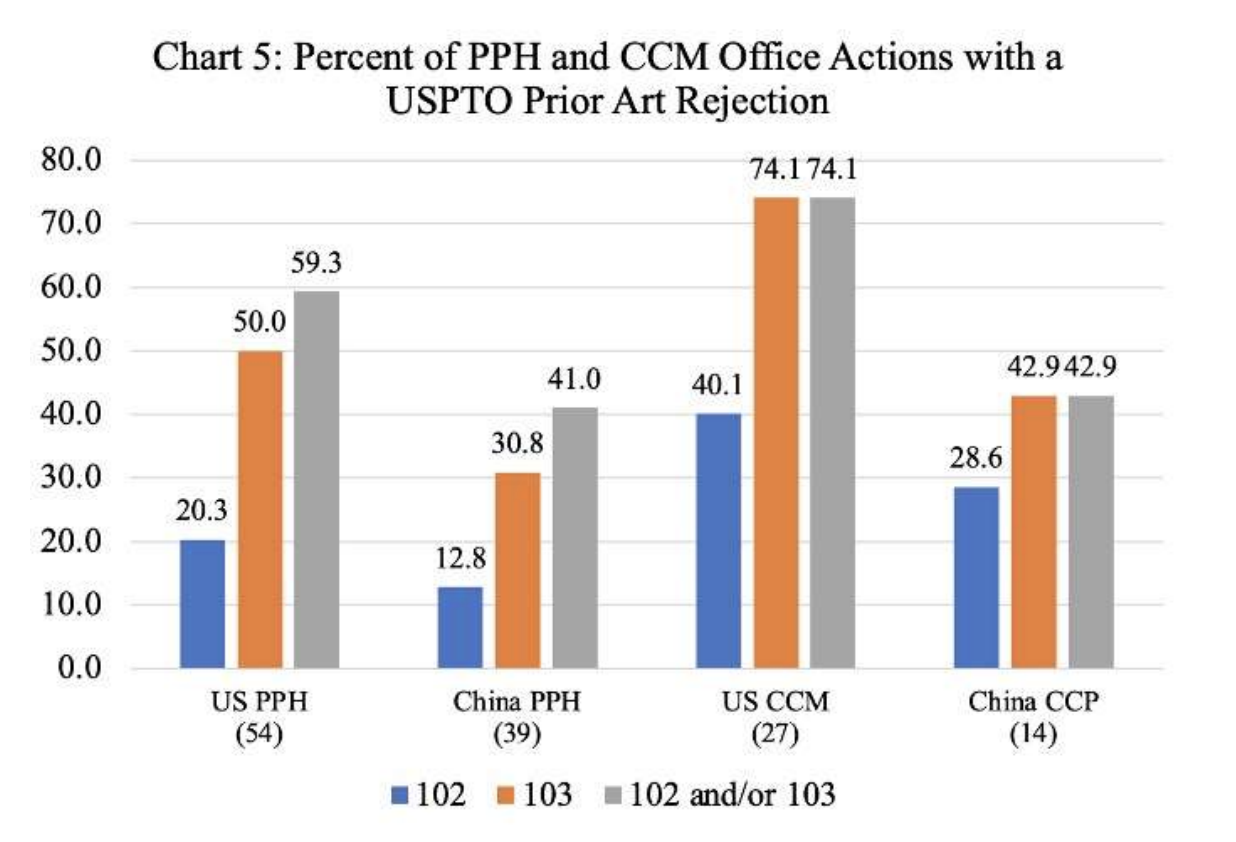
U.S. examiners made fewer prior art rejections for China originating expedited applications as compared to U.S. ones.
Procedural Lapses Exemplified
CCM Serial Number 17/905,166 was allowed in a first action listing more than 25 objections to the claims for lacking antecedent basis, followed by "Ad nauseam … all of the claims have similar antecedent basis issues."
Treating lack of antecedent basis as an objection is inconsistent with the Manual of Patent Examining Procedure, or MPEP, Section 2173.05. Claims found to be indefinite over lack of antecedent basis should be rejected under Title 35 of the U.S. Code, Section 112(b).
Moreover, it is difficult to fathom how claims riddled with so many Section 112(b) issues could have been reviewed for compliance with written description, enablement, anticipation and obviousness requirements.
The examiner indicated that the information disclosure statement had been considered. However, in the IDS, the examiner crossed through the CNIPA's international search report, noting it was not accompanied by an English language statement of relevance or translation.
Three of the four Chinese patents and one Japanese patent cited on the IDS were apparently considered only to the extent possible based on their English language abstracts.
No prior art, enablement or written description rejections were made. The applicant responded by addressing claim informalities and the examiner mailed a notice of allowance. This is how Beijing Goldwind Science & Creation Windpower Equipment Co. Ltd. will receive yet another U.S. patent.
Types of References Cited by International Searching Authorities
Sixty-five percent of U.S. PPHs received first examination by the USPTO International Searching Authority, or ISA.
The Japan Patent Office, European Patent Office and Korean Patent Office acted as OEE for most other U.S. PPHs.
U.S., European Patent Office and Korean Patent Office ISAs more often applied English language documents while China and Japan ISAs more often applied non-English documents.
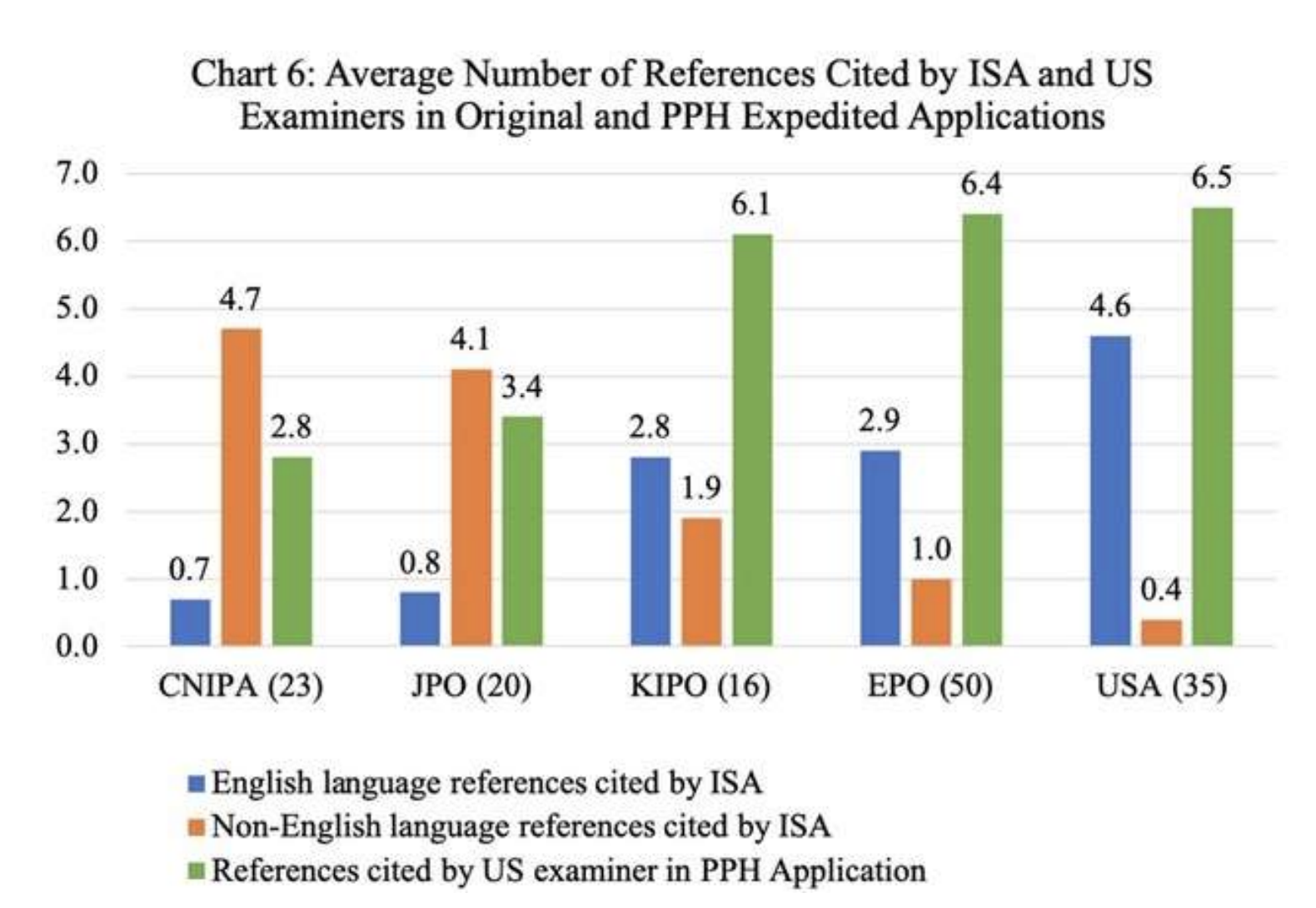
When the PPH had originally been examined in China or Japan, USPTO examiners found fewer relevant documents.
U.S. examiners cited nearly twice as many documents following initial search by the U.S., European Patent Office or Korea
Most USPTO-cited references were in English. Most documents provided by CNIPA were Chinese patents or Chinese patent applications. Ninety-four percent of China PPH and CCMs were national phase filings based on a CNIPA initial exam supported by Chinese patent documents.
Foreign Language Documents Lost in Translation
PPH applicants must comply with the requirements of Title 37 of the Code of Federal Regulations, Section 1.98 and provide an English language machine translation of the OEE's work product which had determined that the claims were allowable.
English language translations of documents cited in the OEE's work product are not required and many appeared to be absent from the Patent Center file, a feature observed more often for Chinese originating PPHs and CCMs.
For PPH U.S. SN 17/687,388, applicant Beijing Naura Microelectronics Equipment Co. Ltd., submitted no full English translations of eight Chinese and one Japanese patent cited by CNIPA's earlier examination. U.S. examination was apparently based upon machine translated abstracts. The examiner cited no other references.
Since at least 1995, the USPTO has encouraged examiners to proceed without human written translations where possible in the early phases of examination under MPEP, Section 901.05(d).
This long-standing practice is counter to the principals of compact prosecution. MPEP, Section 2173, requires examiners to make a clear and complete file record; and MPEP, Sections 707.07 and 2120 require a translation to be obtained so that the record is clear as to the precise facts the examiner is relying upon in support of the rejection.
Moreover, MPEP, Section 901.05(d)'s practice is incompatible with expedited programs which often consist solely of an early examination phase.
Truncated expedited processes restrict the public's ability to file third-party protests under Title 37 of the Code of Federal Regulations, Section 1.291 and likely impede the USPTO's opportunity to perform quality reviews on PPH and CCM rejections and allowances.[7]
Alarmingly, the USPTO limits oral translations to "major European languages and Japanese." MPEP 901.06(a)(D). No provision exists in the MPEP or apparently within the USPTO for examiners to obtain human assistance deciphering Chinese or Korean language documents.
Impact for Big Tech
Since 2009, the USPTO has granted more than a thousand petitions for expedited examination for Huawei Technologies Co. Ltd. Table 1 lists PPHs recently filed by Huawei that were quickly granted.

In U.S. SN 17/468,504, the examiner conducted a speedy examination and allowance even before the PPH petition was reviewed. After the examiner allowed the originally filed claims, the PPH petition dismissed because Huawei had not submitted any prior art references on an IDS.
The claims were allowed over the prior art of record — i.e., the one reference from 2018 that the examiner cited on the PTO892 form.
USPTO's Expedited Examination Processes Favor Applications Originating from China
These results indicate that the USPTO's PPH and CCM programs provide procedurally different examination processes and outcomes for China entities as compared to US applicants. Based on prior CNIPA examination, China-originating expedited applications obtain a higher and faster rate of initial favorable examination and patent grant, a reduced rate of prior art rejections, shorter actions and fewer examiner-cited references.
In contrast, U.S.-filed expedited applications had lower and slower rate of favorable examination and patent grant, received more prior art rejections in longer actions with more US examiner cited references.
Effects on Patent Quality
Congress is investigating concerns Chinese entities are flooding the U.S. with low-quality patents, which contribute to a growing body of Chinese language prior art.[8]
The Special 301 Report issued April 26 by the U.S. Trade Representative says that "large quantities of poor-quality patents continue to be granted" by the CNIPA.[9]
While academics question whether many Chinese patent applications could withstand international evaluation[10] because of the lower quality of its patents, the U.S. intellectual property community should wonder if that flood is spilling over into the USPTO's examination processes.
Congress should investigate whether the USPTO is acting as China's rubber stamp to quickly issue poorly examined U.S. patents for Chinese entities.
Julie Burke, Ph.D., is the founder of IP Quality Pro LLC and an advisor at Petition.ai. She is a former USPTO Technology Center 1600 quality assurance specialist.
The opinions expressed are those of the author(s) and do not necessarily reflect the views of their employer, its clients, or Portfolio Media Inc., or any of its or their respective affiliates. This article is for general information purposes and is not intended to be and should not be taken as legal advice.
[1] USPTO Patent Prosecution Highway Frequently Asked Questions, available at https://www.uspto.gov/sites/default/files/documents/FAQs%20-%20Global%20PPH%20-%2005212015.pdf.
[2] USPTO Patent Prosecution Highway (PPH) — Fast Track Examination of Applications, available at https://www.uspto.gov/patents/basics/international-protection/patent-prosecution-highway-pph-fast-track.
[3] USPTO report examines the impact of Chinese government subsidies and other nonmarket factors on the recent rise in paten t and trademark filings in China. Available at https://www.uspto.gov/about-us/news-updates/breaking-news-uspto-report-examinesimpact-chinese-government-subsidies-and. Jan. 13, 2021.
[4] Julie Burke and Michael Spector. USPTO Climate Change Pilot Program's Debut is Uneven. LAW360. May 2, 2023.
[5] Expansion and Extension of the Climate Change Mitigation Pilot Program. Fed Reg. 88 FR 35841. Announcement June 1, 2023, available at https://www.federalregister.gov/documents/2023/06/01/2023-11660/expansion-andextension-of-the-climate-change-mitigation-pilot-program.
[6] Michael Spector and Julie Burke. The Good, the Bad and the Missing: Findings from a review of the Data on Granted Retroactive Foreign Filing Licenses. IPWatchdog, Jan. 26, 2021.
[7] Raj S. Dave, Sophia Keating and Kyra Dhawan. USPTO's Patent Quality and Pendency Programs are Bearing Fruit. IPWatchdog. Sept. 7, 2021. See Comments.
[8] Charles Duan Testimony entitled Intellectual Property and Strategic Competition with China Part 1. before the Subcommittee on Courts, Intellectual Property and the Internet of the Committee on the Judiciary U.S House of Representatives. March 8, 2023.
[9] 2023 Special 301 Report from the Office of The United States Trade Representative published April 26, 2023 available at https://ustr.gov/sites/default/files/2023-04/2023%20Special%20301%20Report.pdf.
[10] Ana Marie Santacreu and Heting Zhu. What Does China's Rise in Patents Mean? A Look at Quality vs. Quantity. Economic Research Federal Reserve Bank of St. Louis. May 4, 2018.



